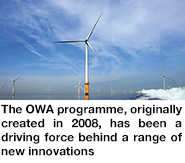Carbon Trust announces winners of subsea inspection competition
01/03/2018

The winners of the challenge were:
- Weld inspection for monopile foundations: Oceaneering International Services Limited, a wholly owned subsidiary of Oceaneering International Inc (Oceaneering) with the development of an inspection tool adapted from previous use in the oil & gas industry.
- Weld inspection for jacket foundations (two winners): Oceaneering, utilising its experience in oil & gas to provide an innovative technique for the inspection of nodes, and Kraken Robotics, a German company having developed a high-resolution laser imaging sensor for the inspection of subsea assets.
- Grout inspection for jacket foundations: Next Geosolutions UKCS, in collaboration with Ashtead Technology and Hydrason, with a technique based on the use of innovative sonar to detect gaps, cracks and the disbanding of grout.
- Grout inspection for monopile foundations (two winners): Uniper Technologies*, having developed its ultrasonic interferometric technique jointly with the British Geological Survey and already showing its success in recent offshore trials, and Next Geosolutions UKCS, with the same technology as for the jacket inspection.
- With the deployment of offshore wind set to almost triple in the next ten years, the need for innovative and low-risk solutions to inspect assets is crucial. Current estimates show that around 35% to 40% of existing monopile fleet, which accounts for the majority of the pre-2012 structures, have potentially been affected by issues relating to grouted joints. Furthermore, many of the structures built post-2012 will require performance monitoring. New designs, such as jackets that are constructed using welded nodes, are also becoming more common and presenting new inspection challenges for the offshore wind industry.
Michael Stephenson, Project Manager of the Foundations Working Area in the Offshore Wind Accelerator, commented: “This competition has once again shown the impressive level of innovation and ingenuity that exists within the industry. The range of winners also highlights the transferability of many techniques from other industries into offshore wind and the potential for other players in these markets to offer services and technologies that could improve operations from both a cost and a health & safety perspective.”
*A report on the project carried out by Uniper Technologies and the British Geological Survey can be found in Insight, Vol 60, No 1, January 2018.